|
De-Havilland Vampire
2003 celebrated two major events in my diary, number one commemorates 100 years of powered flight made by the Wright Brothers from America and closer to home De-Havillands (Spider Crab) D.H.100 Vampire flew for the first time 60 years ago at Hatfield. It seems worthy to mention some details of the first flight of the Wright brothers.
Taking place from Kill Devils Hill, Kitty Hawk, North Carolina on the 17th December, 1903, in an aircraft called the Flyer, Orville piloted the machine 120 feet, staying aloft for twelve seconds, powered by a 12 HP petrol engine connected to two propellers by means of chains. Number two event takes a quantum leap of 40 years to England, and sees the De-Havilland Company join the jet set after the D. H. Vampire D.H.100 takes to the air for the first time from Hatfield with Geoffrey De-Havilland jnr. at the controls. Thirty three years prior to this flight, Geoffrey De-Havilland made his first successful aeroplane without even seeing an aircraft fly or being able to fly one himself, so a bit of history seems in order to pay respect to Geoffrey De-Havilland.
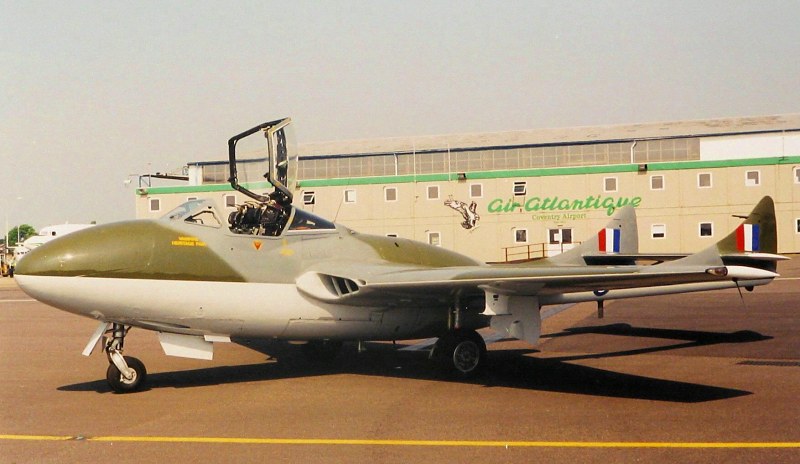
Ex-swiss T.55 (XJ771/G DHAV)
photo by John Bilcliffe
Born the son of a clergyman on the 27th July, 1882, in Haslemere, Surrey, Geoffrey grew up to work as a draftsman in London. It was while here, being bored with his job and in his late twenties in 1909 he turned his interest to aircraft. With a gift of £1,000 from his grandfather and help from his fiancées brother, Frank Hearle, he set about building his first aeroplane. With himself at the controls, the first flight from Crux Easton failed, crashing after breaking a wing on take off, covering only 100 feet. His second aircraft called the FE-1 was a better story, it was so
successful it was bought by the War Office in 1910, the same year as G.D.H. took employment with His Majesty's Balloon Factory in Farnborough. His next aircraft was built for the Royal Aircraft Factory. This was the BE-2 widely used by the Royal Flying Corps in the 1914-18 war. Just before war broke out in 1914 G.D.H. changed employment again, this time working for a private company, AIRCO. It was from here, working as Chief Designer he is best remembered for making the AIRCO DH 4 tandem two seat bomber whose performance was more superior to most fighters at the time when it was fitted with the R.R. Eagle VIII engine, when it became available, entering service in early 1917.
With the demise of the war and lack of aircraft orders AIRCO's assets were a problem and the Company was bought by G.D.H. for around £20,000. With the new company in his own name, De-Havilland set up shop at Stag Lane near London in 1920. The move to the Hatfield site seems to have taken place during the 1930's and by 1941, after production of more famous aircraft, D.H. 84 Racing Comet and Tiger Moth, the plant was heavily involved in production of the Mosquito MK1. During this same year, Sir Henry Tizard, an influential scientist who served with the RAF, approached GDH and his Chief Engineer, Major F. B. Halford, a long time friend, and well known leader in aero engine design, to design and build a jet, complete with new engine. A visit to Frank Whittle of power jets was made to Cranwell in that same year to gain knowledge of the workings of the turbojet, and he in turn was asked to co-operate fully in helping the pair. Reading between the lines I don't think Frank Whittle was happy about
the situation as there was still much to be refined with the running of the engine during various stages of testing. However, the Major was quick on the uptake and his lessons in combustion chamber design and testing from Whittle gave the impetus to simplify his engine and come up with his own modified version in April, 1942. Differing from Whittles reverse flow design, Halford used a centrifugal flow method with 16 straight through combustion chambers, producing 2,300 lb/st., initially called the H-1 Supercharger, this would later be called the H-1 Goblin. The H-1 Goblin was also used to power the Gloster Meteor on its first flight and the American XP-80 later to be known as the T.33 Shooting Star.
Working under Air Ministry specification E6/41 the airframe would be designed around the new engine and also working to meet requirements laid down in the specification brief E6/41 including fitting four 20mm Hispano cannon guns, and achieving a speed of 490 mph. The shape or design chosen was one similarly chosen and rejected by Gloster's Chief Designer, George Carter, whilst working on the Glostor Whittle E.29/39 jet project earlier. Not favoured because of a lack of knowledge of how hot gases released as the jet efflux (exhausts) would effect the tail plane. The design chosen was similar to the American P.38, in the Vampires case the power unit was installed within the main fuselage near to the near to the rear and between the wings. The fuselage was cut short in order for a short jet pipe to be fitted to minimise power loss, with small 'A' shaped intakes one placed on each wing at the wing root.
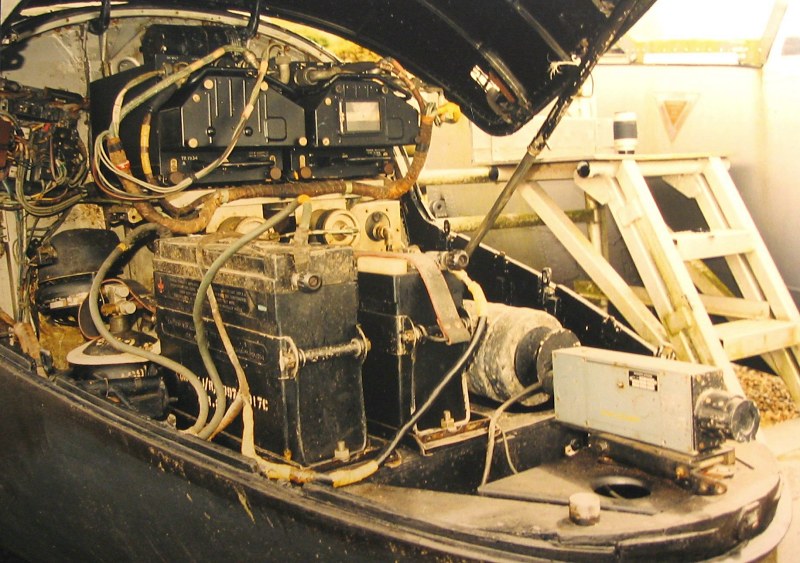
Vampire T11 (WZ557) nose section
photo by John Bilcliffe
|
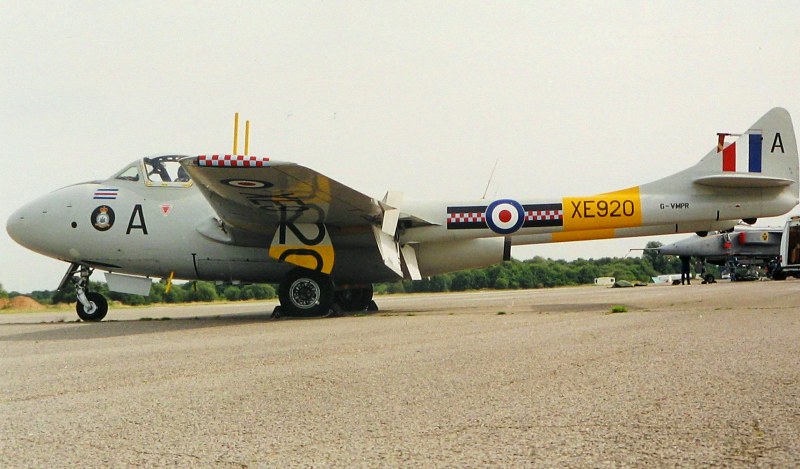
Vampire T11 (XE920/G-VMPR) in markings of 603 Aux Air Sqn. - photo by John Bilcliffe
|
The design incorporated the use of metal and the traditional wood mix used by De-Havilland consisting of a balsa wood core sandwiched by birch-ply going back to the number four bulkhead where the engine was attached making it very light with the metal being used to cover the engine, wings and boom's plus tail plane. Nick named the Spider Crab three prototypes were made with LZ/548G being the first to fly from Hatfield on 20th September, 1943, G.D.H. junior at the controls, the 'G' on the registration indicated the aircraft was guarded at all times on the ground. An initial order of 120 was made in May, 1944, for the now called Vampire F.MK.1 - later this order increased to 300. Production was switched to English Electric at Preston, Lancs, due to Mosquito production at Hatfield. First to fly from the Samlesbury plant was TG274 sporting a new square cut tail fin, later production models from the 40th aircraft onwards were fitted with a more powerful Goblin 2 engine of 3,100 lb/st and under-wing fuel tanks and from the 51st aircraft onwards a one piece bubble canopy and fully pressurized cockpit were included.
The RAF received the Vampire F.MK1 in April, 1946, with 247 sqn., being the first and forming a new wing at RAF Odiham along with 54 and 72 sqn's. Too late for the second war the F.MK1 made its public debut, taking part in fly-over of London on the 8th June, 1946 in Victory celebrations.
During 1945 LZ551 an F.MK1 was specially modified for deck landing trials from HMS Ocean for two days and was labelled the Sea Vampire MK.10. During the period Lt./Cdr., E. M. Brown RNVR made the first ever landing by a jet on the 3rd December, 1945, after taking off from the ship the same day. The success of the trials would spawn Sea Vampire F.MK20 for the Royal Navy. Next came the Mark II (two) made from converting four F.MK1s by fitting them with Rolls Royce Nene engines of 4,500lb/st under specifications order F.11/45, also adding two extra intakes just behind the canopy to help the more powerful engine. The aircraft was not used by the RAF but one of the conversions served as the prototype for the Australian built MK.30.
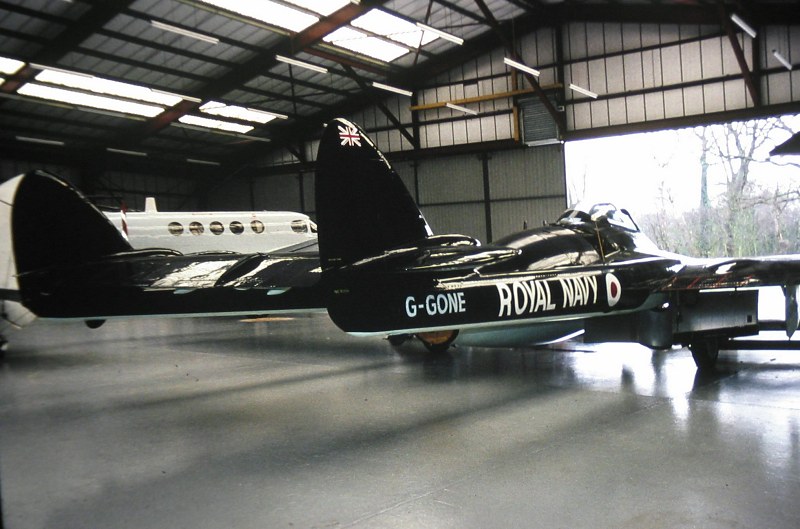
De Havilland 112 Venom FB1 (G-GONE)
photo by John Bilcliffe
| |
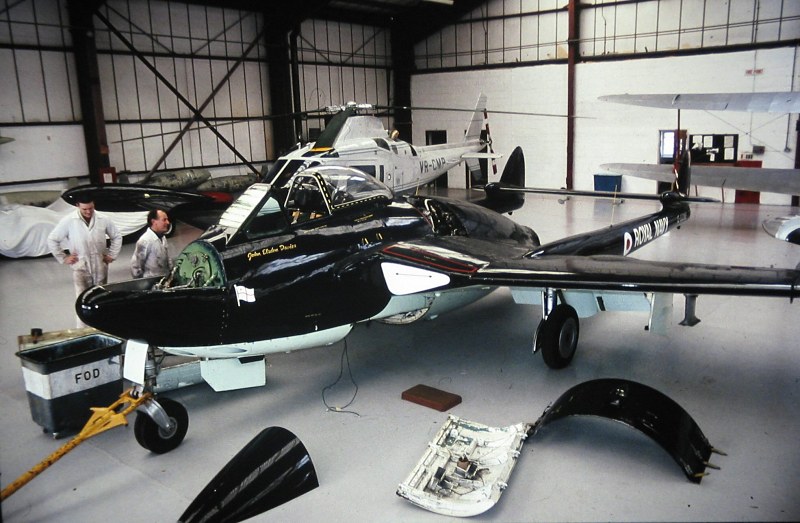
De Havilland 112 Venom FB1 (G-GONE)
photo by John Bilcliffe
|
The F.MK.3 came next with improved range from added drop tanks, these caused stabilisation problems, which were eradicated by modifying the tail unit, entering service in April, 1948, with 54 sqn. In the same year ex-night fighter pilot Ace 'Cats Eyes' Cunningham, now test pilot, took a specially modified Vampire with a metal type canopy to a record height of 59,492 feet. In July of 1948, six Vampires from54 sqn., led by Wing Cdr., D.S. Macdonald DSO-DFC, made the first Trans-Atlantic crossing by a jet fighter, refuelling in Iceland and Greenland. Next the MK.4 as it was designated was an F.MK.1 converted with a R.R. nene engine of 4,500lb/st, planned to make an up-rated F.MK.3, it did not get used.
The FB.MK.5 prototype was made converting an F.MK.1 and strengthening the wing for armament and modifying the undercarriage. TG444 was the first to fly on the 29th June, 1948, and was the most widely used variant serving 30 sqds, at home and abroad from the far east to the Mediterranean. Tropical conditions caused the creation of the next variant and the F.B.MK.9 was made modifying the FB.MK.5 by adding a refrigeration unit plus air conditioning. After the MK.5 variant, one MK.6 was built to be designated FB.MK.6 which was a conversion (TG433), fitted with a Goblin MK.3 engine 3,300lb/st. Not used by the RAF it served as the prototype used by the Swiss Air Force, still keeping the British designation of FB.MK.6. The MK.7s story is the same as the Mk.6s, using a Goblin MK.3 engine it created the export FB.MK.50 without being built, this export version was used by France, Italy and India.
The FB.MK.8 was made converting an FMK.1 TG-278, fitting the ghost two engine 4,400lb/st. This prototype became the precursor to the 112 Venom using the Vampire wing. Perhaps the most interesting variant made was the DH.113 a private venture mixing the Mosquito night fighters nose and canopy onto an FB.MK5s airframe and fitting a Goblin three engine 3,350lb/st. This aircraft became a real cross-breed using the A1 MK.10 radar unit from the Meteor NF.11, it then became known as the Vampire-NF.MK.10 night fighter.

Vampire FB6 (VT871/G-DHXX) at waddington in 1998
photo by John Bilcliffe
| |
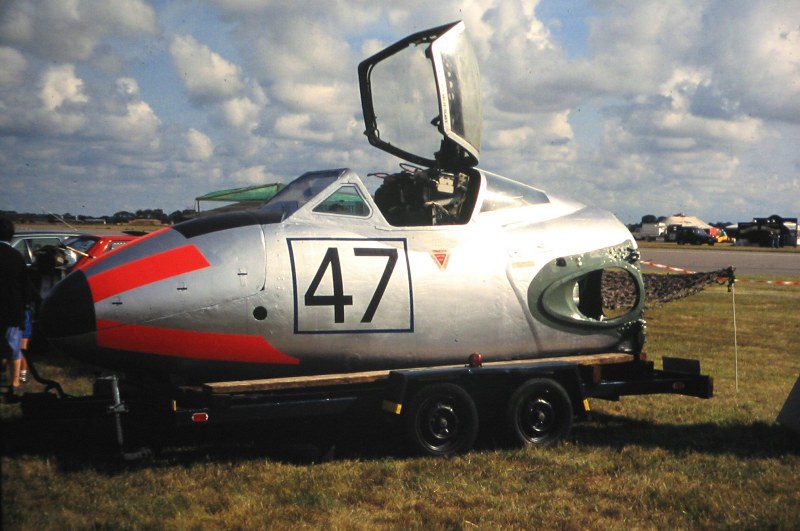
Vampire Cockpit
photo by John Bilcliffe
|
Flying for the first time registered G-5-2 on 28th August, 1949, and entering service with No.25 sqn., of the RAF in July, 1951. An export version was designated NF.MK54 used by Italy and India, and the training version used by the RAF was designated the NF(T)MK.10.
Next and the last variant on from the Vampire family was the trainer the T.MK.11 probably the most well know to enthusiasts today as it can still be seen at air shows throughout the UK and Europe. Operated on a private basis by company's such as De-Havilland Aviation from Bournemouth who operate XE920/G-VMPR. The T.11 started life much the same way as the DH.113 project, a private venture stemming from the Airspeed Division of De-Havilland at Christchurch. This site was bought by G.D.H in 1948 from the Airspeed Company. An NF.10 was converted to make the prototype and under specification T.111 the radar along with two guns were removed, dual controls fitted and a Goblin 35, 3,500lb/st was installed. The aircraft was known as the DH.115 and registered, G-5-7/WW456, first flying on the 15th November, 1950.
An initial order of 147 aircraft was placed on the 3rd October, 1951, which was finally to rise to a total of 530 delivered to the RAF alone, a variant designated Sea Vampire T-22 was made for the Royal Navy with the export version known as the T.55. Australia built their own version designated the T.MK.33, 34 and 35, entering service in 1952.
Modifications were made to the T.11 after the first batch of aircraft were delivered. These included air frame modifications with the help of Martin Baker to fit ejector seats, a moulded one piece canopy and on the booms dorsal (anti-spin) fin extensions were added on. Training on the type was first undertaken by the advanced flying training schools, with Weston Zoyland along with Valley being the first to do this in 1952, later this was filtered down to the ordinary flying training schools and 5 FTS housed at Oakington, Cambs. became the first place to begin the second half of the Provost/Vampire sequence of training. This enabled students to qualify for their 'wings' for the first time ever in the RAF on a jet trainer.
A total of 3,269 Vampire types were built between six plants in the UK and over 1,000 were built under licence to
overseas customers serving some 30 countries. XE-920 was a typical T.11 trainer built at Hatfield in 1955 with construction number (c/n15621) this aircraft served at 1 FTS at Syerston, 5 FTS Oakington and 8 FTS at Swinderby, ending its day at CATCS Shawbury, (Central Air Traffic Control School), placed in storage with 27 MU it moved two more times to Harlow, then Scampton. Put up for sale in 1992 it was purchased by the Vampire Support Team, moved by road to Sealand and registered as G-VMPR in March, 1995. Restoration was carried out before it was moved by road to Chester for a first flight in March, 1996.
Flown to Swansea for further restoration by De-Havilland Aviation, was flown again in 1997 in 603 sqn., R AUX AF 'City of Edinburgh' scheme and now operates out of Bournemouth.
Thanks to Sir Geoffrey De Havilland, OM., CBE., AFC., 1882 to 1965, we can enjoy much of his hard work still. Happy Birthday to the Vampire!
Article and photos by John Bilcliffe
|
|
